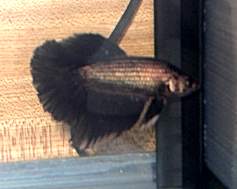Columnaris (Flexibacter columnaris)
Fish Disease
-------------------------------------------------
Disease Type: Bacterial (gram negative rods)
Organism: Flexibacter columnaris
-------------------------------------------------
Names: Columnaris, Cotton-Wool, Cotton-Mouth, Flexibacter, Mouth Fungus
-------------------------------------------------
Description:
Often mistaken for a fungal infection because of its mold-like lesions, Columnaris is a common bacterial infection in cultured fish, particularly livebearing fish and catfish. Its name is derived from columnar shaped bacteria, which are present in virtually all aquarium environments.
-------------------------------------------------
The bacteria are most likely to infect fish that have been stressed by such conditions as poor water quality, inadequate diet, or handling and shipping. Columnaris can enter the fish through the gills, mouth, or via small wounds on the skin. The disease is highly contagious and may be spread through contaminated nets, specimen containers, and even food.
Columnaris can be external or internal and may follow a chronic or acute course. Lesions in chronic cases progress slowly, taking many days before culminating in fish death. In acute cases the lesions spread quickly, often wiping out entire populations of fish within hours. High water temperatures accelerate the progression of the disease; however lowering the water temp will not affect the outcome of the disease.
-------------------------------------------------
Symptoms:
White spots on mouth, edges of scales, and fins
Cottony growth that eats away at the mouth
Fins disintegrate beginning at the edges
'Saddleback' lesion near the dorsal fin
Fungus often invades the affected skin
Rapid gilling in cases where gills are infected
----------------------------------------------------
Most Columnaris infections are external, and present first as white or grayish white spots on the head, and around the fins or gills. The lesions may first be seen only as a paler area that lacks the normal shiny appearance. As the lesion progresses it may become yellowish or brownish in color and the area around it may be tinged red.
Lesions on the back often extend down the sides, giving the appearance of a saddle. On the mouth the lesions may look moldy or cottony, and the mouth will become eaten away. Fins will erode and have a frayed appearance as the infection progresses. The gills filaments will disintegrate as the bacteria invade them, and the fish will begin breathing rapidly due to lack of oxygen. Less commonly, the infection will be internal, and display no external symptoms.
-------------------------------------------------
Treatment:
Change water
Vacuum gravel
Add aquarium salt
Treat with copper sulfate or antibiotic
Discontinue carbon filtration during treatment
-------------------------------------------------------
External infections should be treated with antibiotics or chemicals in the water. Copper sulfate, Acriflavine, Furan, and Terramycin may all be used externally to treat Columnaris. Terramycin has proven to be quite effective both as a bath, and when used to treat foods for internal infections. Salt may be added to the water to enhance gill function. Livebearers in particular will benefit from the addition of salt, however use caution when treating catfish, as many are sensitive to salt.
------------------------------------------------------
Prevention:
Quarantine new fish for two weeks
Maintain high water quality
Provide fish with a nutritionally balanced diet
Medicate fish prophylactically before moving them
Disinfect nets and other equipment before using
-----------------------------------------------------
Because the bacteria thrive on organic wastes, it can be controlled by regular water changes and vacuuming of the gravel. Proper diet and maintaining good water quality in general will keep the fish from being stressed and therefore susceptible to infection. To avoid spreading the bacterium, nets, specimen containers, and other aquarium equipment should be disinfected before each use. Small quantities of aquarium salt can be used to prevent disease in livebearer aquariums. When fish are being shipped or moved, they may be treated prophylactically with antibiotics or by feeding them medicated food.

